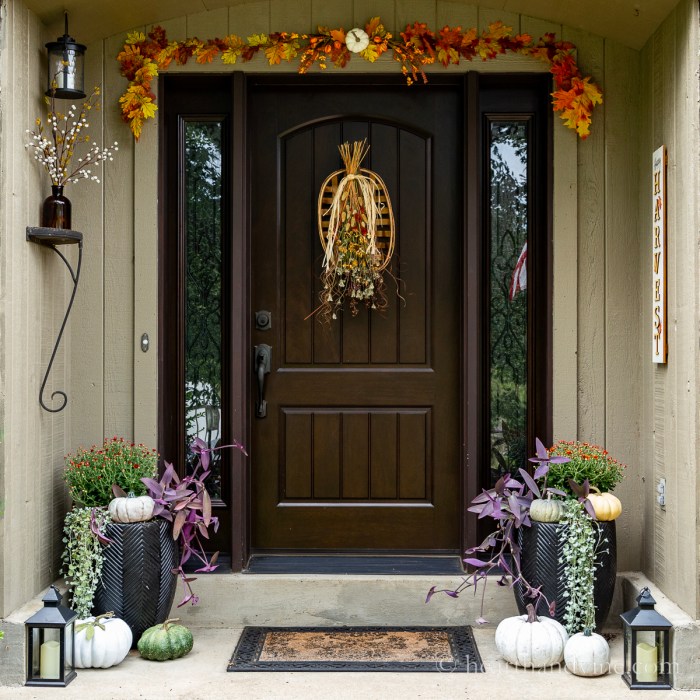Decorative front doors are more than just entrances; they’re the welcoming faces of our homes, setting the tone and style for what lies within. From the classic elegance of Victorian designs to the sleek modernity of minimalist styles, the choice of front door significantly impacts curb appeal and overall aesthetic. This exploration delves into the diverse world of decorative front doors, covering materials, hardware, color palettes, and integration with home design, offering a comprehensive guide to transform your entryway into a stunning focal point.
We’ll examine various door materials—wood, fiberglass, steel, and composite—comparing their durability, aesthetics, and maintenance requirements. We’ll also explore the artistry of door hardware, from traditional knobs to contemporary handles, and how these elements can complement different architectural styles. Color psychology plays a key role, influencing first impressions, so we’ll discuss color choices that enhance curb appeal and reflect personal style.
Finally, we’ll guide you through the process of selecting a door that harmonizes with your home’s architecture and landscaping, ensuring a cohesive and visually striking design.
Integrating Doors into Home Design: Decorative Front Doors

The front door serves as more than just an entrance; it’s a crucial element shaping the overall aesthetic and curb appeal of a home. Selecting the right door style, considering its interaction with the surrounding landscape, and thoughtfully incorporating complementary features like sidelights and transom windows can significantly elevate a home’s architectural character and market value. This section explores the key considerations in harmoniously integrating decorative front doors into home design.
Different door styles inherently enhance various architectural styles. A Craftsman-style home, for example, benefits from a solid wood door with simple, geometric detailing, perhaps featuring glass panels with a leaded-glass design. In contrast, a Victorian home might showcase a more ornate door with elaborate carvings, multiple panels, and perhaps a stained-glass transom. A contemporary home, on the other hand, might benefit from a sleek, minimalist door made of steel or fiberglass, with clean lines and a modern handle.
The door’s material, color, and design elements should all be carefully chosen to complement the home’s existing architectural features and create a cohesive visual narrative.
Door Selection and Landscape Harmony, Decorative Front Doors
Choosing a front door that complements the surrounding landscape requires a holistic approach. Consider the home’s style, the colors of the exterior siding and trim, the landscaping, and even the neighborhood’s overall aesthetic. A rustic home nestled in a wooded area might look best with a wood door in a natural stain, while a modern home on a city lot might be enhanced by a bold-colored steel door.
The scale of the door should also be proportionate to the size of the house and the porch. Overly large or small doors can create an imbalance and detract from the overall visual harmony. Furthermore, the door’s material should be durable enough to withstand the local climate; a wood door might require more maintenance in a humid climate compared to a fiberglass option.
Sidelights and Transom Windows: Enhancing Front Door Design
Sidelights and transom windows, placed flanking or above a front door, significantly enhance both the aesthetic appeal and functionality. Sidelights, typically narrow vertical windows, add width and visual interest to the entryway, while transom windows, situated above the door, introduce natural light and increase the sense of spaciousness. The styles of these elements should complement the front door.
For instance, a Craftsman-style door might pair beautifully with simple, rectangular sidelights and a transom featuring leaded glass. A Victorian-style door might be enhanced with arched sidelights and a transom featuring intricate stained-glass designs. The use of sidelights and transom windows also impacts the home’s energy efficiency, as they can contribute to better natural lighting, reducing the need for artificial lighting during the day.
Craftsman Style Door on a Wraparound Porch
Imagine a Craftsman-style home with a generous wraparound porch. The front door, a rich, dark-stained oak, features simple, geometric glass panels and a sturdy, handcrafted handle. The porch itself is constructed from wide, weathered cedar planks, stained a warm honey tone to complement the door. The porch’s roof is supported by sturdy, tapered columns, and the railings are crafted from the same cedar, creating a unified aesthetic.
Warm-toned, low-voltage LED lighting is subtly integrated into the porch ceiling and railings, casting a soft, inviting glow at night. Large potted ferns and flowering plants are strategically placed along the porch, adding pops of green and color. The overall effect is one of rustic elegance, with the Craftsman-style door serving as the focal point of a welcoming and charming entryway.
The combination of natural materials, warm lighting, and thoughtful landscaping creates a serene and inviting atmosphere.
Ultimately, selecting the perfect decorative front door involves careful consideration of style, material, hardware, and color. By thoughtfully integrating these elements, you can create an entrance that reflects your personality and enhances your home’s value. Remember, your front door is the first impression your home makes—make it count. This guide provides the tools and inspiration to transform your entryway into a statement of refined taste and welcoming charm.
Let your front door tell your story.